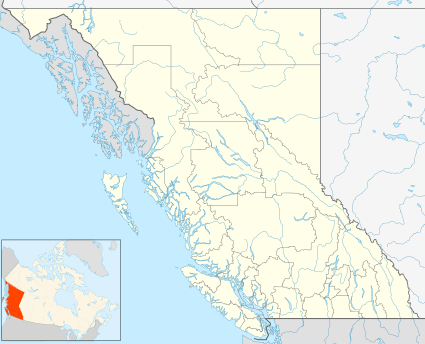Kitsault
Kitsault is an unincorporated settlement on the North Coast of British Columbia, Canada, at the head of Alice Arm, Observatory Inlet and at the mouth of the Kitsault River. The locality of Alice Arm and the Nisga'a community of Gits'oohl (formerly Gitzault Indian Reserve No. 24) are in the immediate vicinity. "Kitsault" is an adaptation of Gits'oohl, which means "a ways in behind".
Kitsault | |
|---|---|
 Kitsault Location of Kitsault in British Columbia | |
| Coordinates: 55°28′00″N 129°29′00″W | |
| Country | |
| Province | |
| Population (2008) | |
| • Total | 1 |
| Area code(s) | 250, 778 |
History
Mining came to the remote valley with the Dolly Varden mine in 1918. Much of the area had been explored for minerals as Anyox and Stewart had mining booms. Alfred Taylor, of Taylor Way fame at Park Royal Shopping Centre, West Vancouver, started the mine with the help of Chicago money. Bunkhouses, stores and a ten-mile-long (16 km) railway were built to access the rich silver ore. The mine operated for only three years until it was held up in litigation. Taylor eventually won the mine and he went on to build the Lions Gate Bridge.
The later town of Kitsault was established in 1979 as the home community to a molybdenum mine run by the Phelps Dodge corporation of the United States. The community was designed for 1,200 residents and included a shopping mall, restaurant, swimming pool and bowling alley.[1] In 1982, however, prices for molybdenum crashed and the entire community was evacuated after just 18 months of residence.
In 2004, the ghost town was bought by Indian-American businessman Krishnan Suthanthiran for $5.7 million; he has spent $2 million maintaining the town.[2] In the end, he would have spent over $20 million more to fully update the town. He has also since closed the town to the public.[3]
In an effort to revitalize the ghost town, Kitsault has been proposed as a location for a liquefied natural gas (LNG) terminal site for the export of natural gas from northwestern British Columbia. LNG pipeline routing to Kitsault has been proposed.[4]
References
- "About Kitsault - History". www.kitsault.com.
- "B.C. ghost town could become major natural gas hub". CBC. 2013-07-31.
- "Ghost Town Mysteries: The 30-year slumber of Kitsault, B.C."
- JANG, BRENT (23 September 2014). "Ghost town to boom town: B.C.'s Kitsault looks to LNG" – via The Globe and Mail.